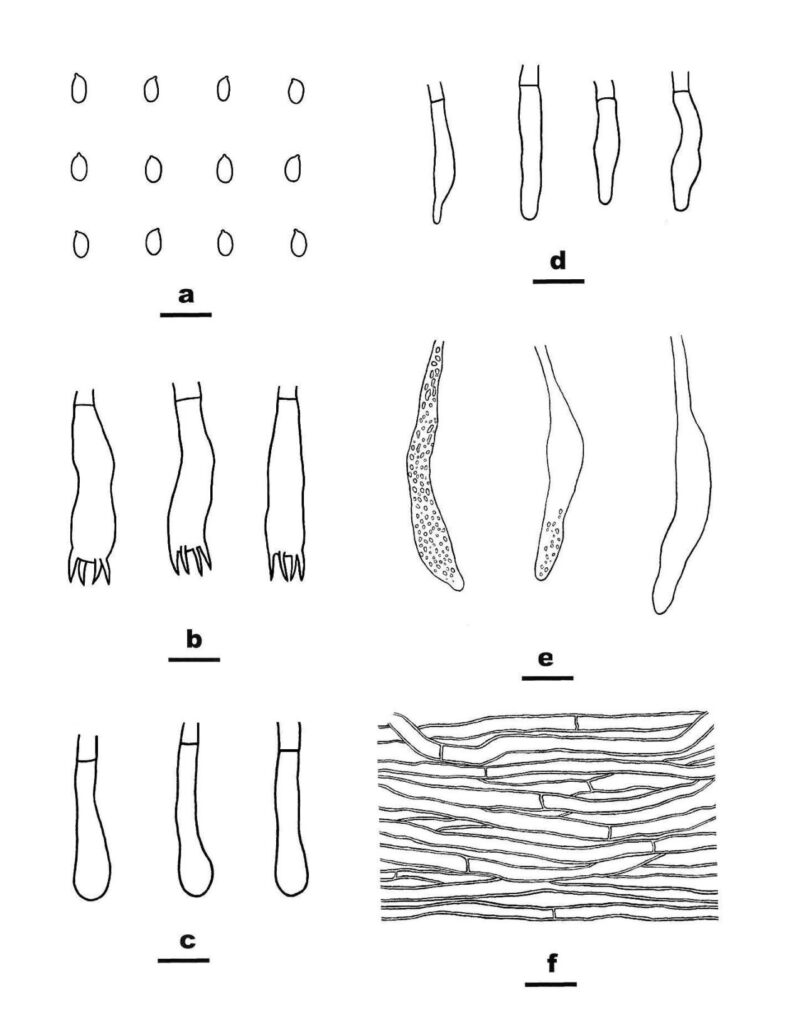Stereum rhododendri S.H. He, Y.F. Cao & Y.L. Xu, sp. nov.
MycoBank number: MB; Index Fungorum number: IF; Facesoffungi number: FoF 12562;
Description
Sexual state: Fruiting body – Basidiomata annual, resupinate, effuse, separable from substrate, coriaceous to crustose, arising as small patches, which soon become confluent up to 7.5 cm long and 2.5 mm wide, 0.7 mm thick. Hymenophore surface slightly tuberculate, light yellow to light brown, not cracked with age; margin thin out, distinct, brownish, 0.4 mm in diam..
Microscopic structures – Hyphal system dimitic, generative hyphae simple separation, colorless, smooth, thin-walled to slightly thick-walled, often septate, moderately branched, more or less parallel to the substrate, 2.5–4 µm in diam. Skeletal hyphae hyaline or brownish, thick-walled, unbranched, not septate, 3–4.9 µm in diam. Cystidia of three kinds: 1) pseudocystidia, colorless, thin-walled, fusiform, with gradually contracted apex, >100 ´ 5 µm, immersed in subhymenium and hymenium, 2) acutocystidia, thin-walled, with pointed apex and slightly projecting, 15–19 ´ 3–4.5 µm, 3) gloeocystida thin-walled, often with internal oil-drops, 19–30(55) ´ 3–5(8) µm. Basidia clavate, colorless, thin-walled, with 4 sterigmata and a basal simple septum, 20–30 ´ 3–6 µm; basidioles dominant; basidioles in shape similar to basidia, but slightly smaller. Basidiospores ovoid, colorless, thin-walled, smooth, amyloid, acyanophilous, (4.2–)5–5.3(–6) ´ 2–2.9(–3) µm,L =5.43 µm,W =2.56 µm,Q = 2.12 (n = 30/1).
Asexual state: not observed.
Material examined: CHINA, Fujian Province, Wuyishan Nature Reserve, on fallen Rhododendron branch, 17 August 2016, He 4483 (BJFC 023924, holotype); .
Distribution: China
Sequence data: ITS: MW263992 (ITS5/ITS4); LSU: MW263976 (LR0R/LR7)
Notes: Stereum rhododendri is characterized by resupinate, effused basidiomata, generative hyphae simple separation, often septate, moderately branched.

Fig. 1. Microscopic structures of Stereum rhododendri (BJFC 023924, holotype). a. Basidiospores. b. Basidia. c. Basidioles. d. Acutocystidia. e. Gloeocystidia. f. Hyphae from subiculum. – Scale bars = 10 µm.
